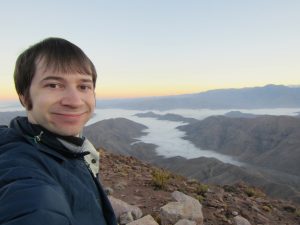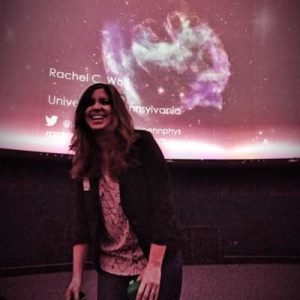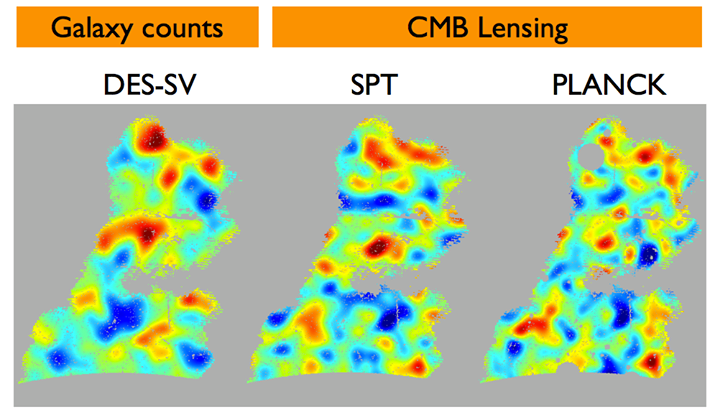Visible and dark matter in the universe, often concentrated in galaxies, causes gravitational lensing of light. In this paper, we find a very significant correlation between locations of DES galaxies, and locations of lensing in the Cosmic Microwave Background (CMB), the source of most light in the universe. This correlation shows that the matter in DES galaxies is responsible for some of the CMB lensing. While there have been similar studies, our extensive measurement of this correlation using 2.5 million DES galaxies allows us to learn a great deal about both large scale structure (LSS), which is the study of how matter clusters in the universe, and dark energy. By doing this measurement at different redshifts, we can study how large scale structure and dark energy have evolved over billions of years.
Shown above are the density of galaxies found by DES, and locations of more or less gravitational lensing in the CMB as seen by the South Pole Telescope (SPT) and Planck Satellite. In the left plot (Galaxy Counts), the red signifies higher density of galaxies; in the right plot (CMB Lensing) red indicates higher amount of lensing. We find these two effects are correlated! The correlations aren’t expected to be perfect between the maps. It’s important to note that the CMB lensing map will also show lensing effects from galaxies and other matter that is further away than DES can see.
We made sure our detection of these correlations was clearly present by accounting for several possible systematic issues. We check, for example, that our galaxy maps are not correlated with the atmospheric conditions during the observations of those galaxies. Even without clouds, the ever-changing turbulence in the air changes greatly our ability to detect faint objects. Without these checks, we could worry that directions in the sky where we observed more galaxies would be a result of better sky conditions at those observing times, and not a true reflection of the distribution of galaxies.
To do cosmological analysis, we separated our sample of galaxies by redshift, which created groups representing different times in the universe. We measure the correlation between 2D maps (i.e., shown above in the figure) of each redshift sample of galaxies, and the CMB lensing maps, seeing what samples produced the most lensing. Our measurements by redshift were consistently lower than the Planck 2015 cosmology theory (which is based on some of our best cosmological measurements) would predict.
We concluded that we indeed could measure correlations for various DES galaxies at different redshifts with CMB lensing. We also found that our measurements were consistently lower than expected across different redshifts. It is exciting how robust this measurement was to many tests, and to think that this was done using only about 130 square degrees of the sky, less than 3% of what DES will eventually observe!
In a broader context, by making measurements at different redshifts we are measuring how the universe is evolving, especially how matter and dark energy may be changing. Our measurements by redshift taken all together would only have about a 10% chance of happening if our current understanding of the matter-energy breakdown of the universe is correct. This could imply something new about dark matter or dark energy, or how much there is of each. However, we probably want to wait for future measurements of galaxies and CMB lensing to make such claims, as later measurements using DES will be even stronger.
About the Paper Author
 Ross Cawthon is an astrophysics PhD candidate at the University of
Ross Cawthon is an astrophysics PhD candidate at the University ofChicago. He works on various projects studying the large scale structure
of the Universe using the millions of galaxies DES observes. These
projects include galaxy clustering, correlations of structure with the
cosmic microwave background, and using the structure of the Universe to infer redshifts of galaxies. Ross is also an active science communicator, volunteering at Chicago’s Adler Planetarium as well as writing and editing for The Darchives. He also loves observing for DES in Chile, where he has observed more than 30 nights.
About The DArchive Authors & Editors

Rachel C. Wolf is an astrophysics PhD candidate at the University of Pennsylvania. She is primarily interested in how to best use Type Ia supernovae to understand more about the evolution of our universe. Most of her work has focused on studying correlations between supernova brightness and host-galaxy properties and on creating new statistical techniques to compare observational data to cosmology theory. Rachel is also very passionate about science education and public outreach. She is involved in many projects in the Philadelphia community and serves as one of the co-coordinators of Education & Public Outreach for DES.
Anthony Kremin is a PhD candidate at the University of Michigan.
